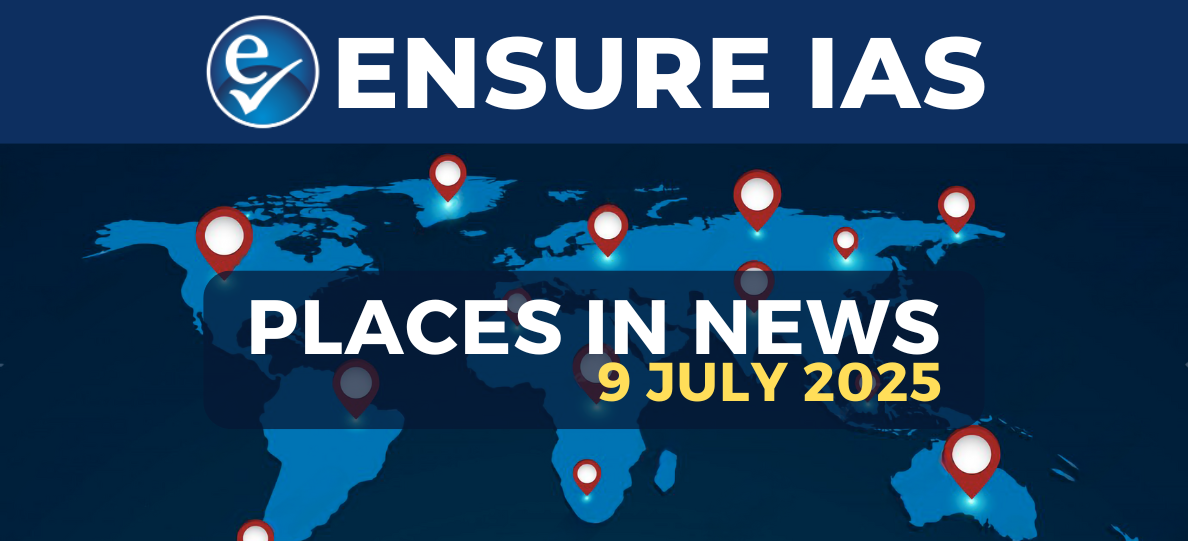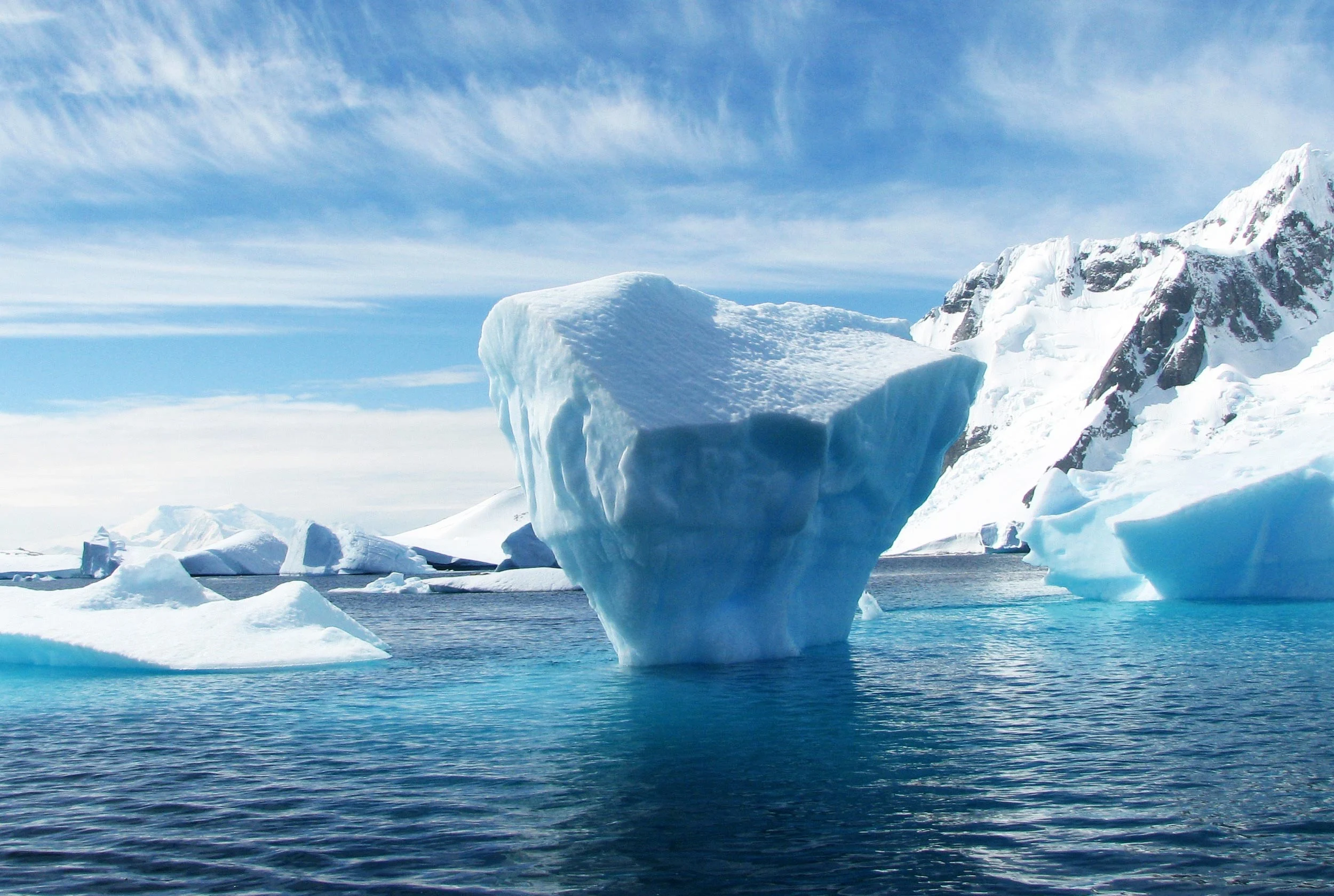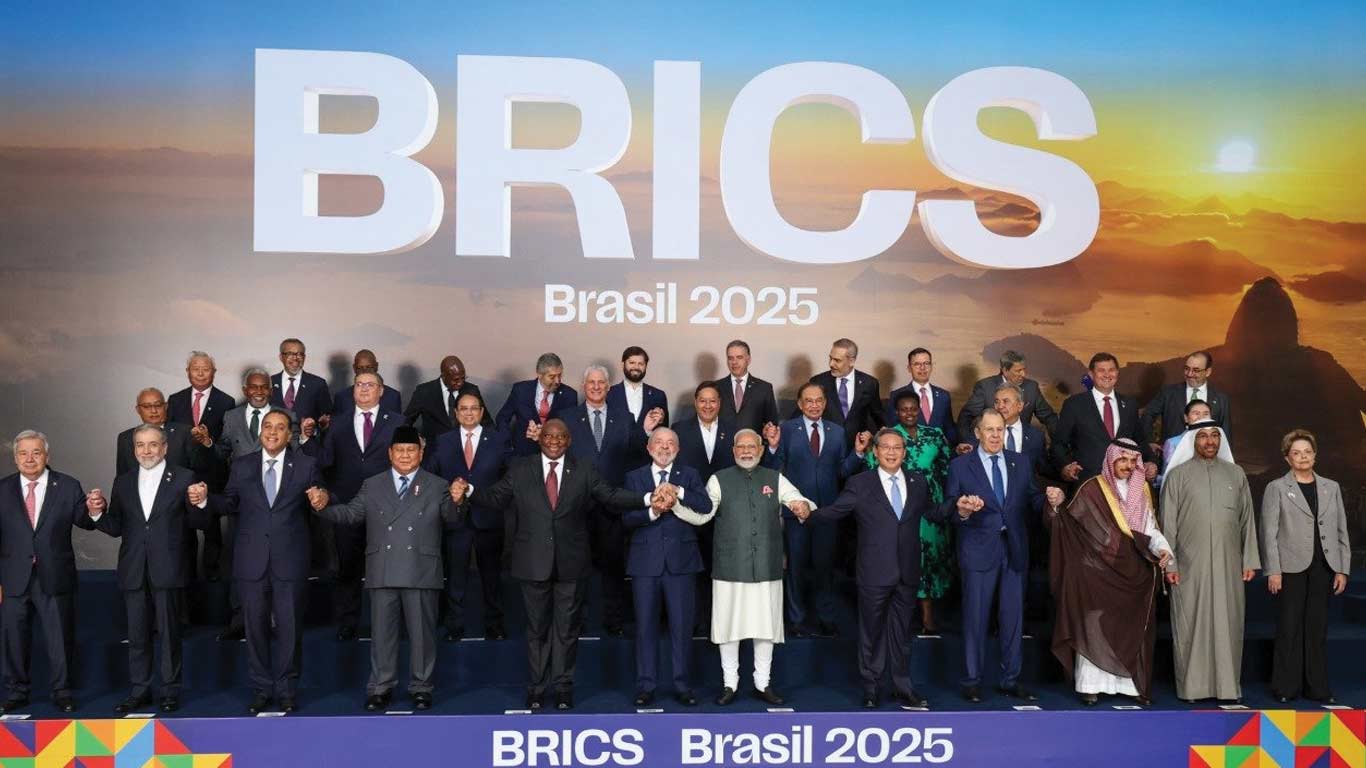- Courses
- GS Full Course 1 Year
- GS Full Course 2 Year
- GS Full Course 3 Year
- GS Full Course Till Selection
- Answer Alpha: Mains 2025 Mentorship
- MEP (Mains Enrichment Programme) Data, Facts
- Essay Target – 150+ Marks
- Online Program
- GS Recorded Course
- Polity
- Geography
- Economy
- Ancient, Medieval and Art & Culture AMAC
- Modern India, Post Independence & World History
- Environment
- Governance
- Science & Technology
- International Relations and Internal Security
- Disaster Management
- Ethics
- NCERT Current Affairs
- Indian Society and Social Issue
- NCERT- Science and Technology
- NCERT - Geography
- NCERT - Ancient History
- NCERT- World History
- NCERT Modern History
- NCERT Medieval History
- CSAT
- 5 LAYERED ARJUNA Mentorship
- Public Administration Optional
- ABOUT US
- OUR TOPPERS
- TEST SERIES
- FREE STUDY MATERIAL
- VIDEOS
- CONTACT US
Volcanoes
Volcanoes

What is a Volcano?
- A volcano is an opening or crack in the Earth's surface that allows molten rock (called magma when underground and lava when it erupts) and Greenhouse gases to escape.
- These materials build up over time and form a mountain-like structure.
- Volcanoes can be found at places where the Earth's outer layers, called tectonic plates (large pieces of Earth's crust), meet.

What is the Difference Between a Volcano, Volcanic Eruption, and Volcanism?
- Volcano: A volcano is the mountain or hill formed by the build-up of volcanic materials like lava, ash, and other debris from past eruptions. These eruptions keep adding material over time.
- Volcanic Eruption: A volcanic eruption is when magma from beneath the Earth’s surface escapes, turning into lava, ash, and gases. It’s the release of this material during an eruption, which can be explosive or gentle.
- Volcanism: Volcanism refers to the set of processes that involve magma moving from below the Earth's surface to the surface, causing eruptions and forming volcanoes.
How Does Magma Form and Move?
- Magma forms when heat inside the Earth melts rock.
- This happens because of high temperatures and pressure deep below the surface.
- Magma is lighter (less dense) than solid rock, so it rises towards the surface.
- As it moves, it may collect in magma chambers (pockets where magma gathers) beneath the volcano.
- When pressure builds up, it forces the magma to the surface in a volcanic eruption.
What Role Does Plate Tectonics Play in Volcanism?
Volcanism is closely connected to plate tectonics (the theory that Earth's outer shell, called the lithosphere, is divided into large, moving pieces known as plates). These plates move and interact in several ways, and where they do, volcanoes can form:
- Subduction Zones:
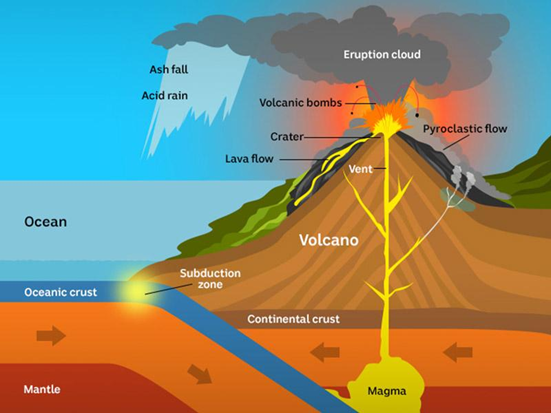
-
- In these areas, one tectonic plate is forced under another. This causes melting, and magma rises to form volcanoes.
- This happens, for example, in the Ring of Fire (a region in the Pacific Ocean where many volcanoes are located).
- Divergent Boundaries:
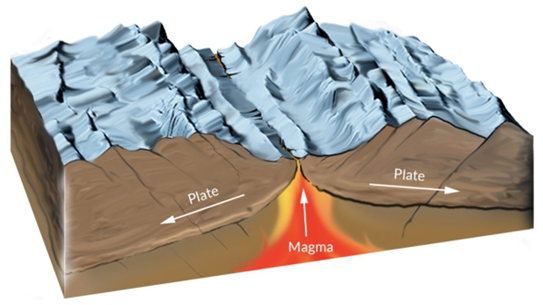
-
- Here, plates move apart, and magma rises up to fill the gap, forming new crust and creating volcanoes.
- A famous example is the Mid-Atlantic Ridge (an underwater mountain range where plates are pulling apart).
- Hotspots:
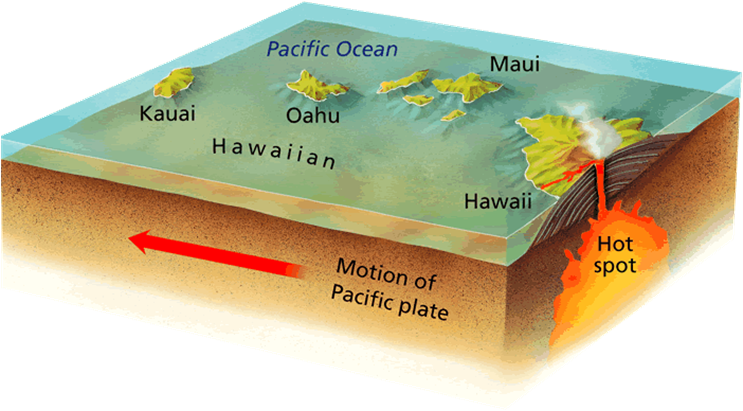
-
- Sometimes, volcanoes can form away from plate boundaries in areas called hotspots.
- These are places where magma rises directly from deep within the Earth, like in Hawaii.
Types of Volcanic Eruptions

What Are Explosive Eruptions?
Explosive eruptions happen when the magma is highly viscous (thick and sticky), meaning it’s harder for gases to escape. The trapped gases build up pressure, which can lead to a violent explosion.
- Characteristics: Explosive eruptions create large clouds of ash, pyroclastic flows (fast-moving clouds of hot gases and debris), and violent blasts. These eruptions can destroy large areas.
- Examples:
- Plinian Eruptions: These are very powerful eruptions that release huge columns of ash and gas into the atmosphere.
- Mount Vesuvius in AD 79, which destroyed Pompeii, had a Plinian eruption.
What Are Effusive Eruptions?
Effusive eruptions are not violent and occur when the magma is low viscosity (thin and runny). This allows gases to escape more easily, so the eruption isn’t as violent. Lava flows steadily out of the volcano instead of exploding.
- Characteristics: Lava flows slowly and can travel far distances, forming wide, gentle slopes on the volcano.
- Examples:
- Hawaiian Eruptions: Lava flows steadily, creating shield volcanoes (volcanoes with broad, gentle slopes).
- Kīlauea in Hawaii is an example of a volcano with these types of eruptions.
- Strombolian Eruptions: Mild eruptions that throw bursts of lava and gas at regular intervals, like the eruptions of Stromboli Island in Italy.
Volcanic Materials

What Are Lava Flows?
When magma reaches the surface, it turns into lava. The way lava moves and cools depends on its type:
- Pahoehoe Lava: This type of lava is smooth and rope-like. It’s runny, so it flows easily and forms smooth, shiny surfaces.
- A’a Lava: This lava is rough and jagged. It is thicker and moves slower, so it cools into sharp, blocky textures.
What is Pyroclastic Material?
Pyroclastic material refers to solid rock and debris thrown into the air during explosive eruptions. These materials include:
- Ash: Tiny rock particles that can be carried far distances in the wind. Ash can disrupt air travel and cause health problems.
- Lapilli: Small stones about the size of a pea, ejected during eruptions.
- Bombs and Blocks: Larger chunks of volcanic rock. Volcanic bombs are round and come from explosive eruptions, while blocks are jagged pieces of solid rock.
What Are Volcanic Gases?
During an eruption, gases are released from magma. Some of the main volcanic gases are:
- Water Vapor (H₂O): The most common gas released by volcanoes. It forms clouds and contributes to rainfall.
- Carbon Dioxide (CO₂): A gas that can contribute to global warming. In high concentrations, it can be dangerous to humans.
- Sulfur Dioxide (SO₂): This gas can combine with water in the atmosphere to create sulfuric acid, leading to acid rain (rain with high levels of acid). It can also cool the Earth by reflecting sunlight.
II. Types of Volcanoes
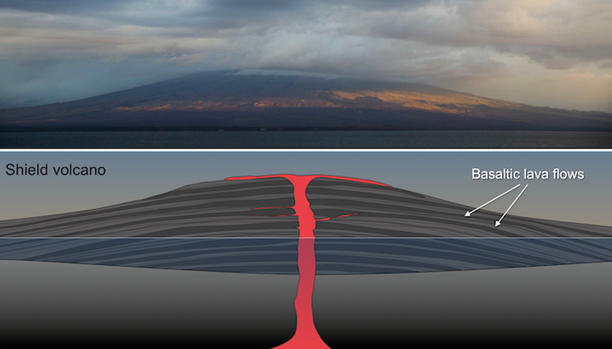
Based on Shape and Structure:
What Are Shield Volcanoes?
- Shield volcanoes are large, broad, and gently sloping mountains formed by the eruption of basaltic lava (a type of thin, runny lava that flows easily).
- These volcanoes get their shape because the lava spreads out over a wide area before it solidifies.
- The eruptions are usually non-explosive, allowing lava to flow smoothly and form wide, gradual slopes.
- Examples: The largest shield volcano in the world, Mauna Loa in Hawaii, is a perfect example.
What Are Composite Volcanoes (Stratovolcanoes)?
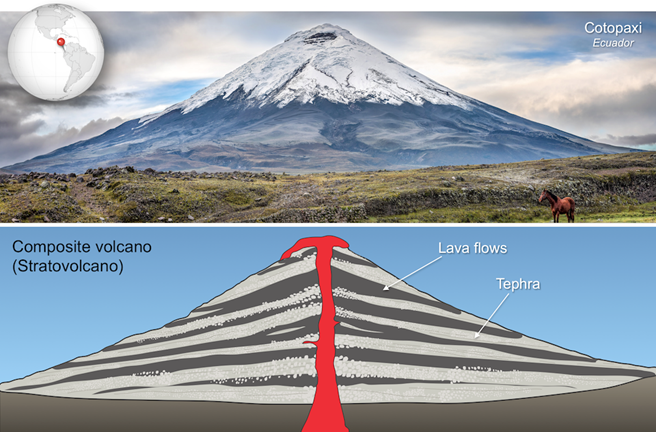
- Composite volcanoes, also known as stratovolcanoes, are tall, steep-sided volcanoes formed by alternating layers of solidified lava and ash or other pyroclastic material (broken-up rock, ash, and gas fragments from explosive eruptions).
- These volcanoes are often very explosive because their magma is more viscous (thicker), trapping gas and causing pressure to build up until it erupts violently.
- Examples: Famous composite volcanoes include Mount Fuji in Japan, and Mount Vesuvius in Italy, which erupted catastrophically in AD 79, destroying Pompeii.
What Are Cinder Cones?
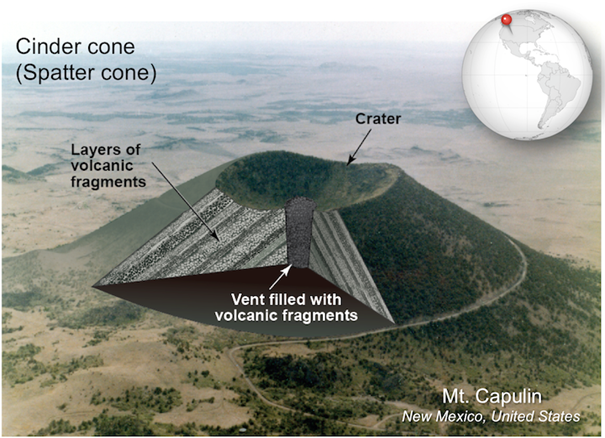
- Cinder cone volcanoes are small, steep-sided volcanoes made from pyroclastic material.
- These volcanoes are formed when volcanic debris, like ash and lapilli (small fragments of rock), falls and accumulates near the vent (the opening of the volcano).
- Examples: Examples of cinder cone volcanoes include Parícutin in Mexico and Sunset Crater in Arizona, USA.
What Are Calderas?

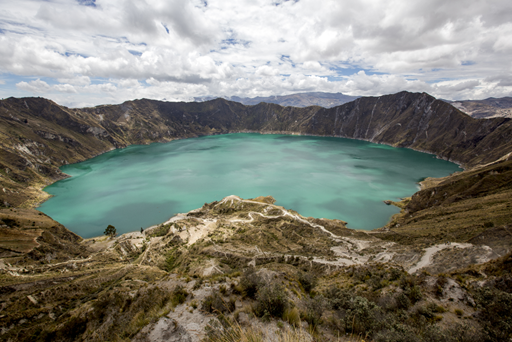
- A caldera is a large, circular depression or crater formed after a massive volcanic eruption.
- When the volcano erupts so violently that it empties out much of its magma chamber (the underground reservoir where magma is stored), the ground above the chamber can collapse, creating a large, deep basin-like structure.
- Examples: Crater Lake in Oregon, USA, is a famous caldera formed from the collapse of Mount Mazama after a massive eruption.
Based on Activity:
What Are Active Volcanoes?
- An active volcano is one that is currently erupting or has erupted recently. These volcanoes are still geologically active, meaning they regularly release magma, gas, and ash.
- Examples: Mount Kilauea in Hawaii, which has been erupting frequently in recent years, is an example of an active volcano.
What Are Dormant Volcanoes?
- A dormant volcano is one that has not erupted in a long time but may still erupt again in the future.
- These volcanoes are considered "sleeping," meaning they are not currently active but have the potential to erupt later.
- Examples: Mount St. Helens in Washington, USA, was dormant for many years before its eruption in 1980, and Mount Fuji in Japan is another dormant volcano.
What Are Extinct Volcanoes?
- Extinct volcanoes are those that have not erupted for a long time and have no potential to erupt again in the future.
- Examples: Mount Etna in Italy was once considered extinct, but it became active again in recent history.
- However, examples of extinct volcanoes include Mount Kilimanjaro in Tanzania and Mount Ararat in Turkey.
III. Global Distribution of Volcanoes

What is the Ring of Fire?
- The Ring of Fire is a region around the Pacific Ocean where a large number of earthquakes and volcanic eruptions happen.
- It’s called the "Ring of Fire" because it forms a ring shape and is known for its frequent volcanic activity.
- This region has about 75% of the world’s active volcanoes.
- Location: It stretches around the Pacific Ocean, including parts of countries like Japan, Indonesia, the Philippines, the west coast of the Americas (like Chile, California), and many others.
- Connection to Plate Tectonics: The Ring of Fire is closely tied to plate tectonics. Volcanoes here form where tectonic plates meet, such as at subduction zones (where one plate is pushed under another) or transform faults (where plates slide past each other).
What Are Other Volcanic Zones?
- Mid-Ocean Ridges:

-
- Location: These are underwater mountain ranges, like the Mid-Atlantic Ridge, which stretches across the Atlantic Ocean.
- Significance: Mid-ocean ridges are formed by divergent plate boundaries (where two plates move apart).
- Example: The Icelandic volcanoes are located along the Mid-Atlantic Ridge and are a result of this volcanic activity.
- Rift Valleys:
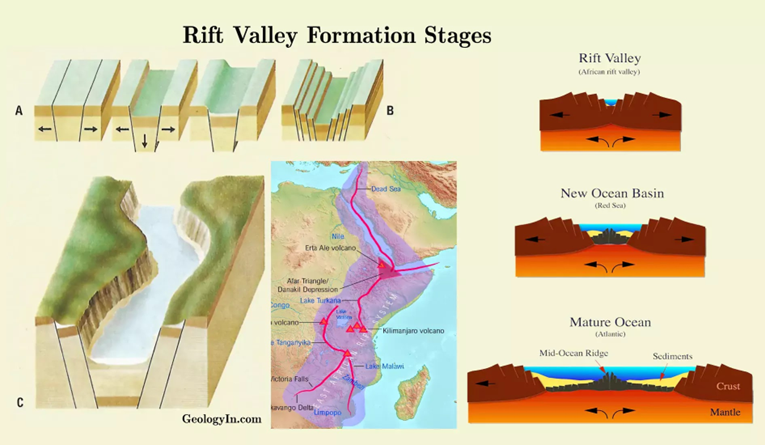
-
- In rift valleys, the Earth's plates are moving away from each other, allowing magma to rise to the surface and form volcanoes.
- Example: Mount Kilimanjaro and Mount Kenya in East Africa are part of the East African Rift Valley system, where volcanic activity is ongoing.
- Hot Spots:
- Hot spots are different from volcanic zones on plate boundaries because they don’t occur where plates meet. They are caused by hot plumes of magma that rise from deep in the Earth.
- Magma rises from a hot, deep part of the mantle.
- Examples:
- Hawaii: The Hawaiian Islands are a result of volcanic activity from a hot spot beneath the Pacific Plate.
- Yellowstone: Yellowstone National Park in the USA sits above a hot spot and has volcanic features like geysers and hot springs.
What Are the Volcanoes in India?
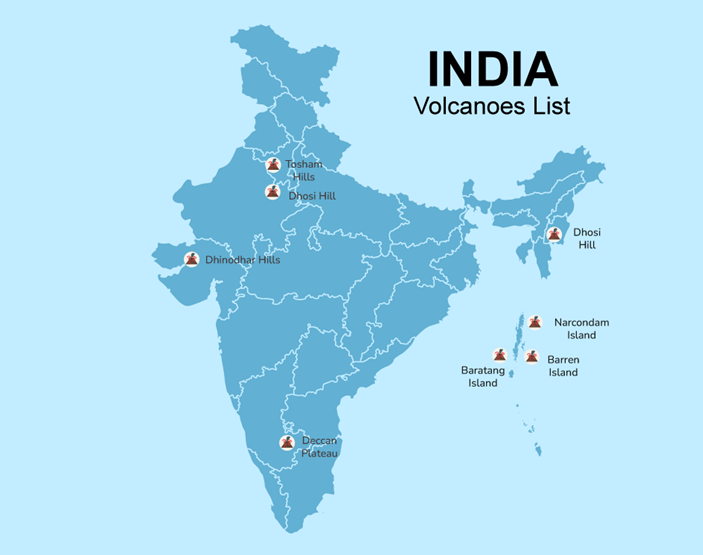
- Barren Island:
- Location: Barren Island is part of the Andaman Islands in the Bay of Bengal.
- Significance: It is the only active volcano in India.
- This volcano erupted most recently in 2017.
- Characteristics: Barren Island is a shield volcano (meaning it has gentle slopes and produces non-explosive eruptions), and its eruptions mainly produce lava flows.
- Narcondam:
- Location: Narcondam is another island located near Barren Island in the Andaman Sea.
- Significance: This is a dormant volcano.
- Characteristics: Narcondam is a cinder cone volcano (formed from volcanic debris like ash and lava fragments) and is smaller compared to Barren Island.
What Are the Secondary Hazards of Volcanic Eruptions?
- Tsunamis:
- A tsunami is a series of large ocean waves caused by a sudden movement of the Earth, such as an undersea volcanic eruption or the collapse of a volcanic caldera (a large crater formed by an eruption).
- Impact: Tsunamis can flood coastal areas, destroy buildings, and cause loss of life. These waves can travel great distances across oceans.
- Climate Change (Short-term Cooling):
- Volcanic eruptions release large amounts of ash and gases like sulfur dioxide (SO₂) into the atmosphere.
- These particles can reflect sunlight, cooling the Earth's temperature for a short period.
- Impact: This temporary cooling can affect agriculture, leading to crop failures, colder winters, and weather disruptions.
- Famine (Crop Damage):
- Famine is a widespread shortage of food.
- After a volcanic eruption, the ash fall can cover crops, and the cooling of the climate can damage agriculture.
- Impact: This can lead to food shortages, hunger, and economic loss in affected areas.
What Are the Socio-economic Impacts of Volcanic Eruptions?
- Volcanic eruptions can destroy infrastructure, making it difficult for people to return to their homes or rebuild their communities. This damages the economy and makes recovery harder.
- Thousands of people can be forced to flee their homes, leading to overcrowded shelters, loss of livelihoods, and long-term hardship for displaced populations.
- The destruction of crops, industries, and transportation routes can lead to job losses, reduced productivity, and a drop in economic output, affecting local and global markets.
What Are the Techniques for Monitoring Volcanic Eruptions?
- Seismic Monitoring:
- Seismic monitoring involves measuring the seismic waves (the vibrations caused by movements inside the Earth) near a volcano.
- Seismometers detect these vibrations.
- Purpose: This helps scientists detect small earthquakes (which often happen before eruptions) and determine if magma is moving below the surface.
- Gas Monitoring:
- Gas monitoring involves measuring the types and amounts of gases, like sulfur dioxide (SO₂) and carbon dioxide (CO₂), released by a volcano.
- Purpose: An increase in certain gases can signal that magma is rising towards the surface, indicating a possible eruption.
- Ground Deformation Measurements:
- Ground deformation refers to changes in the shape of the ground around a volcano, like bulging or sinking. This can be measured using tools like tiltmeters or GPS.
- Purpose: If the ground swells or cracks, it suggests that magma is pushing upwards, which could be a sign of an eruption.
- Thermal Imaging:
- Thermal imaging uses infrared cameras to detect heat from the volcano.
- The cameras capture temperature changes on the volcano’s surface.
- Purpose: An increase in temperature can indicate volcanic activity, as magma rises and heats the ground above it.
What Are the Challenges in Predicting Volcanic Eruptions?
- It is extremely difficult to predict the exact time a volcano will erupt and how intense the eruption will be.
- While scientists can monitor signs of volcanic activity (like seismic waves, gas emissions, and ground deformation), eruptions can still happen unexpectedly or with varying levels of intensity.
- The exact timing and scale of eruptions depend on complex underground processes that are hard to fully understand.
Volcanic Benefits
How Can Volcanoes Provide Geothermal Energy?
- Geothermal Energy refers to the heat from beneath the Earth’s surface that can be used to produce electricity.
- Volcanoes are rich in geothermal energy because of the hot magma below the surface.
- How It Works: Water is pumped underground, where it’s heated by the Earth’s natural heat.
- This steam is then used to turn turbines and generate electricity
- Benefit: Geothermal energy is a clean, renewable source of energy that reduces reliance on fossil fuels.
How Do Volcanoes Lead to Fertile Soils?
- The ash and lava ejected during volcanic eruptions contain rich minerals, which can make the soil very fertile and suitable for agriculture.
- How It Works: When volcanic ash settles on the ground, it breaks down and mixes with the soil, enriching it with nutrients like potassium, phosphorus, and magnesium.
- Benefit: Areas around volcanoes, like the Fertile Crescent in the Middle East, have very productive soils that are ideal for farming.
How Do Volcanoes Lead to the Formation of Mineral Deposits?
- Mineral Deposits: Volcanic activity can lead to the formation of valuable minerals, such as gold, silver, and copper, through the movement of hot water and gases inside the Earth.
- How It Works: When magma cools, it forms mineral-rich rocks. Additionally, hot water circulating through volcanic rocks can dissolve minerals and leave them behind in veins.
- Benefit: Volcanic regions are often rich in minerals, making them important sources of natural resources for mining industries.
|
Also Read |
|
| FREE NIOS Books | |

